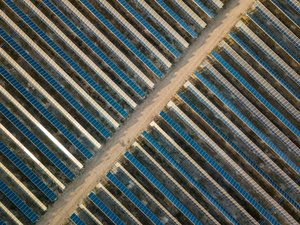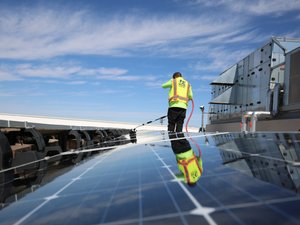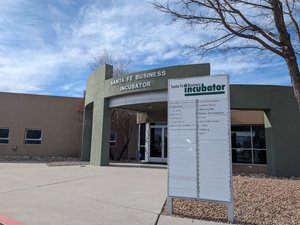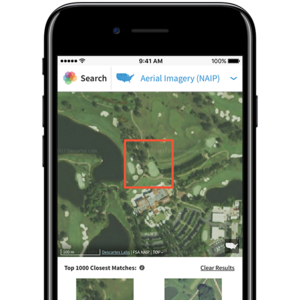
Osazda Energy, an Albuquerque-based solar cell technology startup, recently landed a $1.15 million federal grant that the company's CEO and CTO said will help accelerate its solar cell technology's path to market.
Osazda Energy, which is headquartered at an office in Albuquerque's Sandia Science and Technology Park, is built around a technology licensed through the University of New Mexico. The tech is a sort of additive "paste" for manufacturers of photovoltaic cells, typically used in solar energy installations, that comes with two primary benefits, John Chavez, Osazda's CEO, said — helping prevent PV cells from "cracking," thus making them more resilient, and improving those cells's efficiency.
The paste can increase PV cells's efficiency by .03%, said Sang Han, Ph.D. a chemical and biological engineering professor at the University of New Mexico who developed the tech. It's a number that may sound "minuscule," he added, but when you multiply that efficiency boost across several thousands of cells, it can end up making a significant difference.
Han said PV manufacturers typically use screen printing of silver paste to make electrical contacts, a key component in solar cells. Osazda's composite silver paste would be embedded with engineered additives to make those metal contacts in cells more electrically conducive and resilient to fracture, as opposed to "standard" metallization, he said.
The startup is close to taking its solar cell paste product to market. Han said he wants it to hit the market within the year.
But to get there, Osazda needs to find a solar "expert" to help facilitate that process — someone who can target potential customers and find where the startup's technology best fits. Osazda is "working closely" with a pair of silver paste manufacturing companies as two potential customers, and it's also working with a large PV manufacturing firm headquartered in Shanghai, China, called Trina Solar, to improve its technology's design.
Landing the federal grant will be a big part of that go-to-market path, as well, Chavez and Han said. The U.S. Department of Energy's Office of Science awarded Osazda, alongside 49 other projects across 17 states, a research grant. Osazda's grant, specifically, is a phase two Small Business Innovation Research, a program intended to help small businesses commercialize promising technologies. Osazda's grant is worth $1.15 million, Han said.
Part of that grant money — $50,000 specifically — will be dedicated to market discovery opportunities.
Another, larger chunk of grant dollars will go toward a strategic partnership Osazda recently formalized with a software company called Morphorm, an Albuquerque software firm. The two, Osazda and Morphorm, are working together to further improve PV cell efficiency through something Han called "design optimization."
Essentially, Osazda and Morphorm are testing different PV cell layouts to see which ones help TOPCon solar modules — a modern type of PV technology — conduct electricity most efficiently. While the vast majority of cells use very gridlike layouts, Osazda, with Morphorm's help, is testing layouts that follow a more branch-like, naturalistic pattern.
Initial testing has shown the more naturalistic layout can boost solar cell efficiency. Efficiency, Han said, is a big priority for solar module manufacturers, above other considerations like cell reliability and manufacturing cost.
A combination of Osazda's paste additive, alongside its optimized solar cell design, that the startup hopes can help it break into the PV module market. Both module and silver paste manufacturers, as well as end-customers like solar energy field operators, can benefit from the startup's tech, Han said.
He added the startup has conducted an extensive amount of testing of its paste product, both with a company called D2Solar, based in San Jose, California, using mini-modules, and with Albuquerque-based CFV Labs, a solar testing facility at Mesa del Sol.
Finalizing its go-to-market strategy is the next step. Chavez, Osazda's CEO, said the startup will know more about how much additional money it'll need to commercialize its product once that strategy is ready, whether in the form of equity-based investment or more non-diluted grant dollars.
The New Mexico Start-Up Factory, an Albuquerque-based organization that supports very early stage startups in hitting commercial markets, has worked with Osazda as the startup develops. The startup also landed a phase one Small Business Innovation Research grant worth $200,000 from the U.S. Department of Energy last summer.









